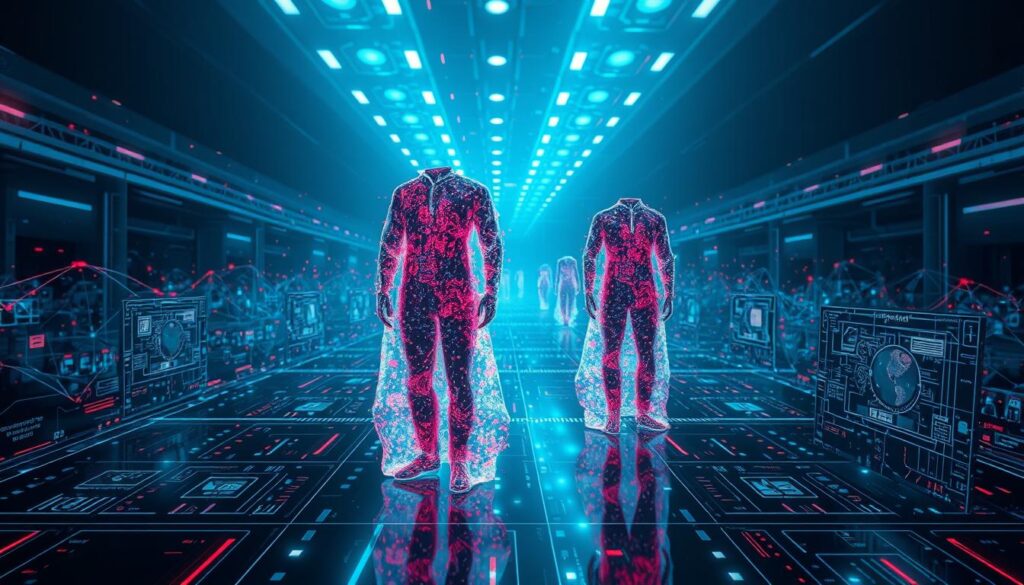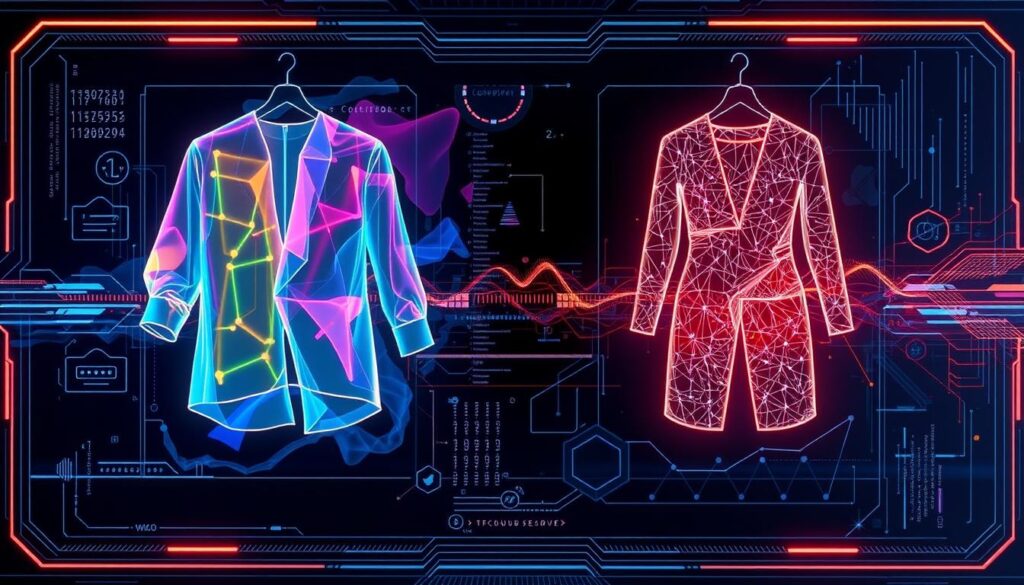Technology is always changing, and one new idea is making waves – AI clothes removers. This tech uses artificial intelligence and computer vision to take clothes off images and videos. It’s used in virtual dressing rooms and the adult industry, but it also raises big questions about privacy and ethics.
This guide will look into how AI clothes removers work, their uses now and in the future, and the ethical and legal issues they bring up. We’ll explore the complex world of digital undressing and its effects on our online lives. You may be interested in reading about Frosting AI: The Ultimate Smart Cake Decorating Solutions.
Key Takeaways
- AI clothes removers use advanced computer vision and machine learning algorithms to digitally remove or manipulate clothing in images and videos.
- This technology has a wide range of applications, from virtual dressing rooms to the adult entertainment industry, but also raises significant ethical and privacy concerns.
- The development and deployment of AI clothes removers pose legal and privacy challenges, as they can infringe on personal autonomy and consent.
- Understanding the inner workings and potential implications of this technology is crucial in navigating the complex landscape of digital undressing.
- The future of AI clothes removers will likely involve continued advancements in the technology, as well as ongoing discussions about the ethical and legal boundaries of its use.
What Are AI Clothes Removers?
AI clothes removers are a new technology that uses artificial intelligence and machine learning. They can take off clothes from images and videos. This tech is great for virtual fashion, digital fun, and online shopping.
Understanding the Concept
These tools use advanced computer vision and deep learning to spot and remove clothes from digital content. They learn from lots of pictures and videos of clothes and people. This lets them take off clothes or change them easily.
Applications and Use Cases
AI clothes removers have many uses across different fields. In fashion, they make virtual dressing rooms possible. Shoppers can see how clothes fit without trying them on. Designers use them to try out new styles and patterns on models.
Outside fashion, they’re used in adult entertainment for “deepfake” content. This raises big ethical questions. The tech itself doesn’t have good or bad qualities. It’s how people use it that matters.
As AI clothes removers get better, we need to think about their ethical sides. We must use this tech responsibly, respecting privacy and consent.
Ethical Concerns with AI Clothes Removers
AI clothes removers bring up many ethical issues. At the top of these are consent, privacy, and the risk of misuse.
Without the person’s okay, AI clothes removers could make images without their say-so. This would break their privacy and lead to digital exploitation. Also, using AI clothes removers for deepfake content raises big privacy and consent worries.
- Ethical issues with AI clothes removers, including lack of consent and privacy concerns
- Potential for digital exploitation and the creation of deepfake content
- Violation of personal autonomy and the need for transparency and user control
“The use of AI clothes removers raises profound questions about bodily autonomy, consent, and the weaponization of technology for nefarious purposes. As a society, we must grapple with these ethical challenges head-on.”
As AI clothes removers get better, it’s key that developers, lawmakers, and us talk about these ethical issues. We need to make sure this tech is used right and with clear rules. These rules should protect our rights and privacy.
How AI Clothes Removers Work
AI clothes removers use machine learning algorithms and computer vision techniques. These systems learn from huge amounts of images and videos. They can spot and pick out clothes in pictures with great precision.
Machine Learning Algorithms
Machine learning is key to AI clothes removers. They use segmentation, masking, and pixel manipulation to remove or change clothes in pictures. This lets them take off clothes digitally. They get better at picking out clothes from the background over time.
Data Training and Image Processing With AI Clothes Removers
The quality of AIclothes removers depends on their training data. Engineers and data scientists work hard to make sure the data is diverse. Advanced image processing techniques help these systems focus on clothes and change them accurately.
Thanks to machine learning and computer vision, AI clothes removers are changing how we use digital clothes. As they get better, we’ll see more ways they can help in fashion and entertainment.
“The accuracy and performance of AI clothes removers are heavily dependent on the quality and diversity of the training data.”
Advances in AI Clothes Removal Technology
The field of AIclothes removers is growing fast. Researchers and developers are always working to make the technology better. They aim to improve its accuracy, speed, and what it can do. Now, they’re using advanced machine learning like generative adversarial networks (GANs) to make the changes look more real.
Getting the accuracy of AI clothes removers right is important. They’re focusing on handling tricky clothing textures, folds, and when things get in the way. This makes the digital dressing room feel more real. Also, they’re exploring how to link AIclothes removers with other tech, like augmented reality. This could bring even more new things to the table.
“The goal is to create a seamless and naturalistic digital undressing experience that empowers users to visualize themselves in different outfits without the physical constraints of trying on clothes.”
The technology is getting better, and so are the ways we can use it. We’ll see it in virtual fashion shows, online shopping, personalized style advice, and even in education. The latest advancements in AI clothes removers are changing how we see and experience fashion online.
Privacy and Legal Implications
AIclothes removers are getting more advanced, raising big questions about privacy and the law. This tech can make images without the person’s okay, taking away their right to privacy. It also makes it easy for bad people to create fake content, leading to legal problems.
Consent and Personal Autonomy
The debate over AIclothes removers centers on consent and personal freedom. People have the right to control their own images. But, this tech could take that away.
There’s a big worry about how AI clothes removers could be misused. They deal with very private data like personal pictures and biometric info. So, we need strong rules to protect our privacy.
“The development of AI clothes removers raises significant concerns about the erosion of personal privacy and the potential for non-consensual use of sensitive data.”
We need strong laws to manage AIclothes removers. This ensures our privacy and consent are safe. Without these rules, this tech could seriously harm our rights and freedom.
The Future of Digital Undressing
The world of AI clothes removers is changing fast. It brings both new chances and challenges. This tech could change many industries and how we see ourselves and our culture.
AI clothes removers could change how we shop for clothes and design them. They might let us try on clothes online in a very real way. This could make shopping easier and help us choose better.
But, these new techs also bring up big questions about privacy and rights. There’s a lot of talk about how to use this tech right. We need strong rules to protect our privacy and make sure this tech is used well.
The trends in AIclothes removers show us a big change is coming. We need to think about the right way to use this tech. By doing so, we can make sure it helps us without hurting anyone’s privacy or rights.

“The future of AI clothes removers is a complex and multifaceted topic, with both exciting possibilities and significant ethical concerns that must be carefully navigated.”
Conclusion
AI clothes removers are changing the game with their potential uses, from movie magic to fashion. But, they also bring up big ethical and privacy questions. We need to tackle these issues carefully.
As AIclothes removers get better, we must work together. This means policymakers, industry leaders, and the public all playing a part. We need to make sure this tech is used right and with respect for everyone’s privacy and freedom.
By being thoughtful and balanced, we can enjoy the good things AIclothes removers offer. At the same time, we can protect our rights and values. This way, we can make the most of this tech safely.
FAQ’s About AI Clothes Removers
What are AI clothes removers?
AIclothes removers use artificial intelligence and computer vision to remove or change clothes in images and videos. They have many uses, like virtual dressing rooms and adult entertainment.
What are the ethical concerns with AI clothes removers?
AIclothes removers raise big ethical questions. They could be used without consent, leading to privacy issues and digital exploitation. This could also violate personal rights without permission.
How do AI clothes removers work?
AIclothes removers use machine learning and computer vision. They learn from lots of images and videos to spot and remove clothes. This creates the look of digital undressing.
What are the latest advancements in AI clothes removal technology?
AIclothes removers are getting better all the time. Researchers are improving their accuracy and speed. Now, they use advanced machine learning to make changes look more real.
What are the privacy and legal implications of AI clothes removers?
AIclothes removers bring up big privacy and legal worries. They could be used without consent, breaking privacy laws. There’s also fear of misuse to create fake content.
What is the future of digital undressing technology?
Digital undressing tech is getting more advanced. It could change many areas, like fashion and virtual shopping. But, there are worries about misuse and ethical issues.
What keywords are relevant to AI clothes removers?
Keywords for AI clothes removers include: ai clothes removers, digital undressing, ai image manipulation, virtual dressing rooms, computer vision, machine learning, privacy concerns, ethical issues, consent, deepfakes, digital exploitation, data privacy, regulation, emerging trends, social and cultural impact.

